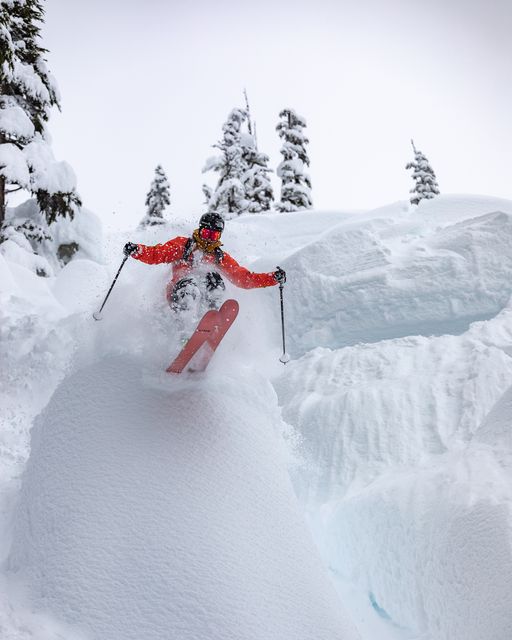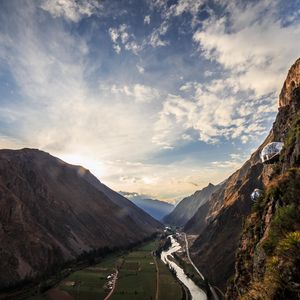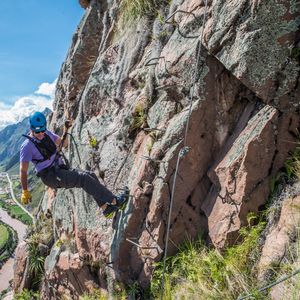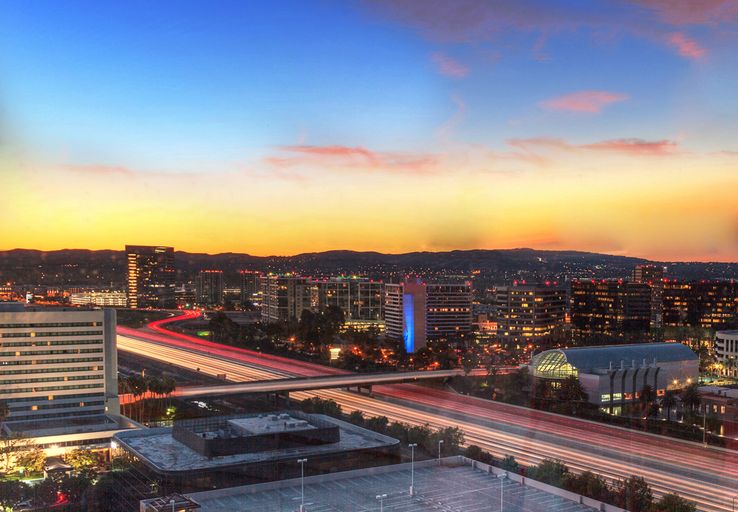
The Next Vacation Horizons
Every traveler has his or her own tolerance for risk, so while some define adventure by sampling scorpions in Bangkok, others prefer plunging into frigid polar waters. Remote destinations like Greenland, Patagonia and Antarctica first come to mind, but serious adventures can also be found closer to home, with thrill-seekers gravitating to whitewater rafting in the Grand Canyon or bungee jumping from a Chicago skyscraper. Extreme travelers, for whom even those adrenaline rushes are too routine, may opt for chasing tornadoes, wind walking or even confronting Mount Everest.
Storm Chasing Adventure Tours provides guests close encounters with Mother Nature’s most destructive outbursts in Tornado Alley, under the supervision of veteran storm chasers on six-day tours originating in Oklahoma City or Denver. “Our goal is to share our knowledge and appreciation for severe weather, to seek out and witness spectacular, explosive supercell thunderstorms, stunning, vivid lightning, large hail, massive wall clouds, and violent tornadoes,” says tour leader and severe storm expert Todd Thorn. “We can’t guarantee tornadoes, but you’ll witness supercell thunderstorms on most tours,” he reports.

Photo credit: Northern Escape Heli-Skiing
Wing walking, literally stepping across the wing of an aircraft while it undertakes gut-wrenching aerobatics, is generally not for the kind of tourist content to be sitting poolside at the hotel. At Mason Wing Walking Academy outside of Seattle, adventurous travelers spend hours training for this exhilarating experience with premier wing walking instructor Marilyn Mason. Ultimately, the trainees conduct 25-minute walks at altitudes up to 3,500 feet above the scenic Olympic Peninsula as Marilyn’s husband and third-generation aerobatic pilot Michael Mason takes his vintage Stearman biplane through its maneuvers.
“We get our share of adrenaline junkies and thrill-seekers, but some people just love aviation or want to experience something unique,” reports Marilyn Mason, who adds, “We draw from all over the world.” Mason quips, “In addition to families and couples, many come solo, because it’s not for everybody!” She encourages students to combine the experience with a trip to nearby Olympic National Park, which offers exceptional kayaking, hiking and whale watching.
Skylodge Adventure Suites combines comfort and adventure on a sheer cliff overlooking Peru’s Sacred Valley. Guests ascend to their precarious-looking accommodations by scaling a steep rock formation outside the ancient city of Cusco. The destination, 1,300 feet above ground and 11,000 feet above sea level, is reached via ferreta (clutching onto cables) or, more easily, by ziplining. Hugging the side of the steep cliff are luxury pods that provide occupants with the illusion of floating above the valley.
The suites, approximately 200-square-foot capsules with 300-degree visibility, feature solar-powered electricity and private bathrooms with the most spectacular views ever encountered when nature calls. “Skylodge offers you the opportunity to sleep hanging on a cliff with all the comfort of a regular hotel, plus the magic of Sacred Valley’s starry skies and views of Inca ruins,” states Natalia Rodriguez, CEO of Natura Vive, the property operator. Those afraid of heights may demur, but no previous experience in climbing is required, as parts of the 90-minute ascent are relatively horizontal with opportunities for resting.

Photo credit: Natura Vive
Guests include eco-tourists, daredevils and romantic couples from around the world, reports Rodriguez, who notes the minimum age requirement is 15. “Food is prepared at a restaurant in Urubamba — carried up by our guides in heavy backpacks — so you can enjoy a delicious and gastronomic Peruvian meal,” says Rodriguez. Natura Vive also operates Starlodge Adventure Suites, which hang over Sacred Valley but require no hiking or ziplining to access.
While some travelers relish height, recharging at Peru’s Skylodge Suites, others choose a different direction. That alternative might be sleeping underground in Tennessee’s Cumberland Caverns, more than 300 feet beneath the surface of the earth. Various overnight packages are offered, involving scaling underground rock formations or squeezing through muddy passages before bedtime. For something cushier than a sleeping bag, consider the White Cliffs Underground Motel, built into a mesa in the Australian Outback.

Photo credit: Natura Vive
Because traversing 26.2 miles is challenging even for professional athletes, marathons are not usually held in harsh environments, but intrepid runners drawn by the romance of the Sahara Desert may nonetheless consider competing in Marathon des Sables. The seven-day ultra-marathon — it attracts about 1,250 runners from more than 50 nations — covers 155 sunbaked miles through Morocco and, with triple-digit temperatures, 60-plus health care professionals are on hand. Many participants endure the ordeal of Marathon des Sables to raise money for worthy charities.
Most skiers are dependent on existing ski lifts at alpine resorts, thereby missing out on better powder and more audacious runs found in truly remote settings. Eliminating such constraints is heli-skiing, which transports skiers to pristine wilderness settings by helicopter, a high-end adventure gaining popularity from Alaska to Iceland. Northern Escape Heli-Skiing provides skiers and snowboarders access to a spectacular mountainous area of British Columbia so vast its size rivals that of some nations. Overnight accommodations range from a rustic, quintessential Canadian lodge to a private luxury villa with a dedicated culinary team, concierge and massage therapist.
Most of Northern Escape’s guests are from Europe and the U.S., drawn to British Columbia’s copious snowfalls, scenic alpine terrain and favorable weather, some spending more than $100,000 for private packages. President and CEO John Forrest reports, “Heli-skiing is growing into a very high-end holiday. It’s very decadent to be flown to the top of a mountain for skiing, then enjoy five-star lodging and cuisine in a private chalet.”
Providing an extreme vacation opportunity for serious divers is Seaventures Dive Rig, a hotel fashioned from a decommissioned oil rig just off the coast of Borneo. Its guestrooms are somewhat spartan — nothing like the overwater bungalows at the region’s five-star resorts — but for those who care more about diving than the thread count on their bed linen, Seaventures Dive Rig is genuine paradise. Travelers insisting on greater luxury may consider the Underwater Room at Manta Resort, anchored to the ocean floor off the Tanzanian coast. This corner of the Indian Ocean is one of the world’s premier diving areas, but the suite’s underwater bedroom provides similar thrills without ever putting on a wetsuit.
Not everybody is prepared to climb Mount Everest, but Highland Expeditions gives travelers an opportunity to trek to — and sleep overnight at — the storied base camp of the world’s highest mountain. This is a vacation that affords lifelong bragging rights without risking one’s life attempting to reach Everest’s summit. Although guests ascend no further up the mountain, this is still an arduous 17-day trek that reaches an elevation above 18,000 feet. A trek to base camp in the spring is particularly scenic, featuring colorful blossoms that eventually yield to the harsh but exquisite conditions of the Himalayan highlands. For those craving more than just a taste of base camp, Highland Expeditions’ experienced sherpas escort the world’s most ambitious travelers to the summit of Mount Everest.

Photo credit: Above Space Development Corporation
Travelers inclined to plan their vacations well in advance might look skyward to Voyager Station, a proposed outer space hotel housing 300-plus guests, slated for occupancy by 2030. Above Space Development Corporation promotes the project as providing amenities that include spacious accommodations, stunning views of the Earth, Moon and stars, restaurant-quality cuisine, and exercise facilities, along with earthlike toilets and showers. Additionally, at least a handful of other companies purport to transport tourists into space even sooner, so the final frontier has never been more attainable.
By Roger Grody This article originally appeared in Homes & Estates magazine.
SHARE





